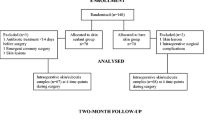Abstract
Groin wound infection is a dreaded complication of vascular surgery and may jeopardize an underlying graft. A variety of skin closures have been used and the object of this study was to prospectively determine the relationship between skin closure and wound infection. One hundred fourteen consecutive patients (70 men and 44 women) undergoing bypass surgery with a groin incision (n = 173) were randomly assigned to skin closure with subcuticular Maxon, interrupted nylon, continuous nylon, or clips following a standard two-layer closure of subcutaneous tissue. Fourteen (12%) patients had diabetes and 50 (44%) had digital ulceration and gangrene. Aortofemoral bypass was performed in 25% of the patients and infrainguinal bypass in the remaining 75%. Perioperative wound cultures were obtained before closure. Wounds were inspected and cultures repeated on postoperative days 3, 5, 7, 10, and 14. Infection was defined as a positive culture. Groin wound infection occurred in 3% of the population and graft infection in 0.6%. The type of suture did not influence the incidence of infection. This study failed to demonstrate a significant difference in the incidence of wound infection with the use of different suture materials. We conclude that suture material should be selected on the basis of surgeon preference and costs.
Similar content being viewed by others
References
Goldstone J, Moore WS. Infection in vascular prostheses: Clinical manifestations and surgical management. Am J Surg 1974;128:225–233.
Liekweg WG, Greenfield LJ. Vascular prosthetic infections: Collected experience and results of treatment. Surgery 1977;81:335–342.
Landreneau MD, Raju S. Infections after elective bypass surgery for lower limb ischemia: The influence of preoperative transcutaneous arteriography. Surgery 1981;90:956–961.
Bunt TJ. Synthetic vascular graft infections. I. Graft infections. Surgery 1983;93:733–746.
Edwards WH, Martin RS, Jenkins JM, et al. Primary graft infections. J Vasc Surg 1987;6:235–259.
Schwartz ME, Harrington EB, Schanzer H. Wound complications after in situ bypass. J Vasc Surg 1988;7:802–807.
Shanik GD, Moore DJ, Feeley TM. The value and limitations of in situ bypass: Realistic expectations. In Veith FJ, ed. Current Critical Problems in Vascular Surgery, vol 1. St. Louis: Quality Medical Publishing, 1989, pp 34–39.
Clarke AM, Poskitt KR, Baird RN, et al. Anastomotic aneurysms of the femoral artery: Aetiology and treatment. Br J Surg 1989;76:1014–1016.
Johnson JA, Cogbill TH, Strutt PJ, et al. Wound complications after infrainguinal bypass. Classification, predisposing factors, and management. Arch Surg 1988;123:859–862.
Wengrovitz M, Atnip RG, Gifford RRM, et al. Wound complications of autogenous subcutaneous infrainguinal arterial bypass surgery: Predisposing factors and management. J Vasc Surg 1990;11:156–163.
Paterson-Brown S, Cheslyn-Curtis S, Biglin J, et al. Suture materials in contaminated wounds: A detailed comparison of a new suture with those currently in use. Br J Surg 1987;74: 734–735.
Author information
Authors and Affiliations
About this article
Cite this article
Murphy, P.G., Tadros, E., Cross, S. et al. Skin closure and the incidence of groin wound infection: A prospective study. Annals of Vascular Surgery 9, 480–482 (1995). https://doi.org/10.1007/BF02143863
Issue Date:
DOI: https://doi.org/10.1007/BF02143863




